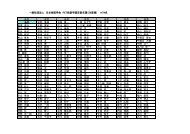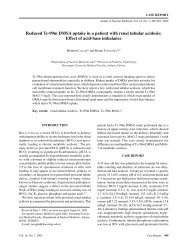Radiopharmaceutical management of 90Y/111In labeled antibodies ...
Radiopharmaceutical management of 90Y/111In labeled antibodies ...
Radiopharmaceutical management of 90Y/111In labeled antibodies ...
You also want an ePaper? Increase the reach of your titles
YUMPU automatically turns print PDFs into web optimized ePapers that Google loves.
γ-counter are not affected by the presence <strong>of</strong> high levels<br />
<strong>of</strong> quenching agent. Samples displaying a 25%–70% difference<br />
in counting efficiency during Cerenkov counting<br />
generate identical cross-over tables upon assay in a γcounter<br />
(data not shown).<br />
Administration to patients<br />
Complete administration <strong>of</strong> 90 Y/ 111 In-pharmaceuticals to<br />
the patient is attained via certified and single-use tubing<br />
and materials with the set-up as shown in Figure 1. After<br />
completing the administration <strong>of</strong> the radiopharmaceuticals<br />
and flushing the bottle and tubes twice, the remnants <strong>of</strong><br />
radioactivity in the administration equipment were, approximately,<br />
1–20 MBq as measured in the radionuclide<br />
dose calibrator. We concluded that at least 98% <strong>of</strong> the<br />
radiopharmaceutical was administered successfully.<br />
After completion <strong>of</strong> the infusion, blood samples were<br />
taken from the patient during a period <strong>of</strong> 2 weeks for<br />
biodistribution purposes. Serum levels <strong>of</strong> 90 Y/ 111 In <strong>labeled</strong><br />
<strong>antibodies</strong> were determined by means <strong>of</strong> the methods<br />
described above. An example is given in Figure 5<br />
showing an exponential decrease <strong>of</strong> serum radioactivity<br />
to about 20% <strong>of</strong> the initial value during two weeks<br />
following injection. 90 Y- and 111 In-anti-CEA behave identically<br />
in this respect. This is not as evident as it seems to<br />
be. After subjection to in vivo degradation for as long as<br />
14 days, 90 Y and 111 In ions (free or bound to remnants <strong>of</strong><br />
the protein moiety) may behave differently in the patient’s<br />
circulation. Apparently, this is not the case. Similar curves<br />
were obtained from other patients (not shown).<br />
DISCUSSION<br />
The results mentioned above illustrate that standard routine<br />
equipment can easily be adapted to the manipulation<br />
<strong>of</strong> 90 Y. The procedures described for the <strong>management</strong> <strong>of</strong><br />
90 Y are compatible with GMP guidelines for the production<br />
<strong>of</strong> radiopharmaceuticals for human use. The radiation<br />
safety measures described above contribute to the three<br />
main objectives, i.e. speed <strong>of</strong> action, distance to the<br />
radiation source and shielding. Although not completely,<br />
shielding results in acceptable exposure levels throughout<br />
the entire procedure without hampering the manipulations<br />
necessary for preparation and administration.<br />
After completion <strong>of</strong> patient administration <strong>of</strong> the 90 Yimmunoconjugate<br />
by infusion, protective measures<br />
concerning the patient and his/her environment are not<br />
recommended. 15<br />
The use <strong>of</strong> volumetric calibration curves instead <strong>of</strong> the<br />
adaptation <strong>of</strong> the isotope-specific calibration factors <strong>of</strong><br />
the radionuclide dose calibrator allows an accurate and<br />
volume-independent determination <strong>of</strong> the amount <strong>of</strong><br />
radioactivity. Use <strong>of</strong> these curves in future instances<br />
contributes to a reduction <strong>of</strong> manipulations and hence<br />
diminishes the radiation burden and as well as the likelihood<br />
<strong>of</strong> unintentional needlestick injuries.<br />
580 Formijn J. van Hemert, Gerrit W. Slo<strong>of</strong>, Kirsten J.M. Schimmel, et al<br />
The high energy <strong>of</strong> electrons emitted by 90 Y enables its<br />
quantification by means <strong>of</strong> liquid scintillation counting in<br />
a Cerenkov window. 12,16–18 The need <strong>of</strong> quench correction<br />
has, as far as we know, not yet been documented for<br />
these measurements. An advantage is the absence <strong>of</strong> a<br />
count rate contribution by γ-emitting isotopes. In a “classical”<br />
liquid scintillation system (using counting fluid),<br />
efficiencies <strong>of</strong> 90 Y-counting may reach up to 100%. In this<br />
scintillation system, however, 111 In is expected to interfere,<br />
since it has been reported that the unquenched<br />
spectrum <strong>of</strong> 99m Tc (pure γ-emitter with an energy lower<br />
than that <strong>of</strong> 111 In) fits into a 0–150 keV window ( 14 C). 19<br />
We used 1000–2000 MBq <strong>of</strong> 90 Y-<strong>labeled</strong> antibody for<br />
patient therapy in combination with 120–150 MBq <strong>of</strong><br />
111 In-<strong>labeled</strong> antibody for imaging purposes. At these low<br />
111 In/ 90 Y ratios, the main limitations for a reliable application<br />
<strong>of</strong> 111 In/ 90 Y cross-over tables are the conventional<br />
considerations regarding background contribution and<br />
counting statistics. At high 111 In v/ 90 Y ratios, the forward<br />
scatter and pileup <strong>of</strong> 111 In sets a limit to reliability, when<br />
its contribution to the count rate in energy window B<br />
reaches 90 Y count rate levels. One may try to suppress this<br />
phenomenon by setting the lower level <strong>of</strong> the high-energy<br />
window B at a higher position.<br />
In conclusion, the procedures described above <strong>of</strong>fer<br />
adaptations <strong>of</strong> local conditions for achieving safe and<br />
well-documented production and patient administration<br />
<strong>of</strong> combined 90 Y/ 111 In pharmaceuticals.<br />
REFERENCES<br />
1. Wiseman GA, White CA, Witzig TE, Gordon LI,<br />
Emmanoulides C, Raubitschek A, et al. Radioimmunotherapy<br />
<strong>of</strong> relapsed non-Hodgkin’s lymphoma with Zevalin,<br />
a 90 Y-<strong>labeled</strong> CD20 monoclonal antibody. Clin Cancer Res<br />
1999; 5: 3281s–3286s.<br />
2. Witzig TE, White CA, Wiseman GA, Gordon LI,<br />
Emmanoulides C, Raubitschek A, et al. Phase I/II trial <strong>of</strong><br />
Zevalin TM ( 90 yttrium ibritumomab tiuxetan; IDEC-Y2B8)<br />
radioimmunotherapy for treatment <strong>of</strong> relapsed or refractory<br />
CD20 positive B-cell non-Hodgkin’s lymphoma. J Clin<br />
Oncology 1999; 17: 3793–3803.<br />
3. Juweid ME, Swayne LC, Sharkey RM, Dunn R, Rubin AD,<br />
Herskovic T, Goldenberg DM. Prospects <strong>of</strong> radioimmunotherapy<br />
in epithelial ovarian cancer: results with 131 I<strong>labeled</strong><br />
murine and humanized anti-carcinoembryonic antigen<br />
monoclonal <strong>antibodies</strong>. Gyneco Oncol 1997; 76:<br />
259–271.<br />
4. Juweid ME, Hajjar G, Swayne LC, Sharkey RM, Suleiman<br />
S, Hersko T, et al. Phase I/II trial <strong>of</strong> 131 I-MN-14(F(ab)2 anticarcinoembryonic<br />
antigen monoclonal antibody in the treatment<br />
<strong>of</strong> patients with metastatic medullary thyroid carcinoma.<br />
Cancer 1999; 85: 1828–1842.<br />
5. Sharkey RM, Goldenberg DM, Murthy S, Pinsky H, Vagg<br />
R, Pawlyk D, et al. Clinical evaluation <strong>of</strong> tumor targeting<br />
with a high-affinity, anticarcinoembryonic-antigen-specific,<br />
murine monoclonal antibody, MN-14. Cancer 1993; 71:<br />
2082–2096.<br />
Annals <strong>of</strong> Nuclear Medicine







